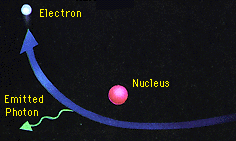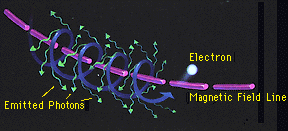Generations of X-rays
X-ray emitted by all the X-ray sources are results of few fundamental physical
mechanisms, such as, black body radiation, bremsstrahlung, synchrotron
radiation, compton scattering etc.
Black body radiation
All bodies in the universe at temperature above absolute zero emit electromagnetic
radiation with a characteristic distribution over energy (spectrum) determined
by their temperature. For most of the objects on earth, including human beings,
this radiation falls in infrared band, whereas, the Sun with surface
temperature of 6000 K, emits predominantly in optical region. If the temperature
of a body becomes extremely high, of the order of 107 K, then its radiation
will be predominantly in X-ray band. There are many exotic objects which
exist in our universe having such high temperature, viz. neutron stars, white
dwarfs, accretion disks around compact stars etc. The only mode to study
such objects is to observe them in X-ray band.
Bremsstrahlung
Bremsstrahlung originates from the acceleration of electrons in coulomb
collisions with other electrons and with
ions
and nuclei. It comes from the German, 'brems' for breaking, and 'strahlung'
for radiation. The most common situation is the emission from a hot gas
as the electrons collide with the nuclei due to their random thermal motions.
This is called 'thermal
bremsstrahlung
'. Bremsstrahlung can also occur when a beam of particles decelerates on
encountering an obstacle. Thermal bremsstrahlung produces a characteristic
spectrum
. Each collision event can be regarded as producing a
photon
, and the energy of the photon corresponds approximately to
the change in energy |

|
suffered during the collision. The electrons in a gas have a distribution
of energies, with the mean proportional to the temperature. The distribution
of photon energies produced by bremsstrahlung reflects the electron energy
distribution, and has an average which is proportional to temperature.
Thus, a measurement of the spectrum can be used to determine the temperature
of the gas.
Synchrotron Radiation
Synchrotron radiation is associated with the acceleration suffered by electrons
as they spiral around
magnetic field lines.
. The force felt by a charged particle in a magnetic field is perpendicular
to the direction of the field and to the direction of the particle's velocity.
The net effect of this is to cause the particle to spiral around the direction
of the field. Since circular motion represents acceleration (i.e., a change
in velocity), the electrons radiate photons of a characteristic energy,
corresponding to the radius of the circle. For non-relativistic motion,
the radiation spectrum is simple and is called "cyclotron radiation". The
frequency
of radiation is simply the gyration frequency, which is given in terms
of the magnetic field as |

|

where B is the field strength, e is the electric charge,
m is the particle (electron)
mass
, and c is the speed of
light
. Cyclotron and
synchrotron radiation
are strongly polarized; detection of polarization is regarded as strong
observational evidence for synchrotron or cyclotron radiation.
The situation becomes more complicated when the particle energy is
relativistic
(i.e., their speed approaches the speed of light). This is more common
in
astrophysical
objects. In this case, the radiation is compressed into a small range of
angles around the instantaneous velocity vector of the particle. This is
referred to as 'beaming', and it results in a spreading of the energy spectrum
in a way that depends on the momentum of the particle in the direction perpendicular
to the field. In such a case, there is still a maximum photon energy that
can be radiated, which is proportional to the field strength and inversely
proportional to the particle momentum.
Synchrotron spectra typically have a power law shape, i.e., the
flux
proportional to photon energy to some power. This is due to the fact that
the particle momenta also have a power law distribution. They are commonly
observed in the
radio
region of the spectrum, but can extend to the X-rays and beyond. Clearly,
both synchrotron and cyclotron emission apply only to particle motion perpendicular
to the direction of a magnetic field. Real gases must also have particle
motions parallel to the field, and radiate ordinary thermal bremsstrahlung
from this component of their motion.
Compton Scattering
This process does not generate new photons, but scatters photons from lower
to higher energies (or vice versa) in interactions with electrons of higher
(or lower) energies. The non-relativistic version is called "Thomson scattering"
and results in negligible change in photon energy. In the most widely discussed
scenario, low energy photons (UV, optical, or below) scatter with relativistic
electrons, making X-rays and/or
gamma-rays
. This should actually be called 'inverse Compton', since it is the inverse
to the process first described by Arthur Compton, but the distinction is
often not made by astronomers. The fractional energy transfer per scattering
is
 where T is the electron temperature, m is the electron mass,
and k and c are the
Boltzmann constant
and the
speed of light
, respectively. Thus, unless kT is much greater than mc
2 (which is unlikely) many scatterings are required in order to
shift an optical or UV photon into the X-ray band. The resulting spectra
are referred to as 'saturated' or 'unsaturated' depending on whether sufficient
scatterings have occurred to shift all the photons to the electron energies.
In the former case, the photon spectrum will resemble the electron energy
distribution. In the latter case, the photon spectrum is a power law spectrum
extending from the UV/optical up to the electron characteristic energy.
Unsaturated Compton spectra are currently considered one of the most likely
mechanisms for making the hard (greater than 10 keV) X-rays observed from
many classes of objects, including active
galaxies
and
black hole
binaries in our Galaxy.
where T is the electron temperature, m is the electron mass,
and k and c are the
Boltzmann constant
and the
speed of light
, respectively. Thus, unless kT is much greater than mc
2 (which is unlikely) many scatterings are required in order to
shift an optical or UV photon into the X-ray band. The resulting spectra
are referred to as 'saturated' or 'unsaturated' depending on whether sufficient
scatterings have occurred to shift all the photons to the electron energies.
In the former case, the photon spectrum will resemble the electron energy
distribution. In the latter case, the photon spectrum is a power law spectrum
extending from the UV/optical up to the electron characteristic energy.
Unsaturated Compton spectra are currently considered one of the most likely
mechanisms for making the hard (greater than 10 keV) X-rays observed from
many classes of objects, including active
galaxies
and
black hole
binaries in our Galaxy.
|


